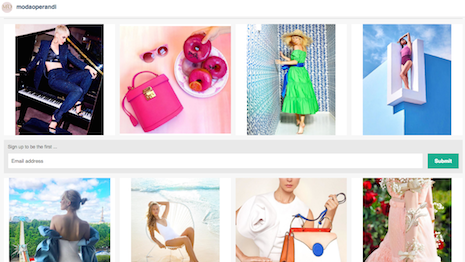- About
- Subscribe Now
- New York,
July 31, 2017

 The Moda Operandi page on like2b.uy that lets visitors click on an image to buy merchandise. Image credits: Moda Operandi and like2b.uy
The Moda Operandi page on like2b.uy that lets visitors click on an image to buy merchandise. Image credits: Moda Operandi and like2b.uy
The media landscape has evolved significantly since the birth of the first fashion magazines in the 1840s.
Digital and, in particular, social media, has revolutionized how media is consumed. Here is how the fashion media scene is changing:
1. Consumer clustering
Rather than typing in the webpage address of their favorite magazine, consumers are clustering in multi-functional social media and messaging applications to access all the fashion content that is relevant and interesting to them.
Publishers must grab attention in Instagram, Snapchat Discover or Twitter feeds to ensure their content is seen.
2. From programmatic to performance
Fashion retailers are shifting in budgets towards direct response marketing.
Programmatic spend has increased five-fold between 2013 and 2016 and now represents more than 70 percent of advertising spend.
Going forward, fashion retailers will need to re-balance brand and performance marketing spends to grow or defend brand affinity.
3. Customized content
Personalized custom content can create engaging brand experiences, early on in the consumer journey.
From smart, data-driven video messaging in mobile using real-time data, to digital baggage carousel screens in airports, there are now multiple ways to effectively target consumers using smart data.
4. Driving footfall via geolocation
Though traditionally seen as separate ecosystems, the digital world can be used to drive bricks-and-mortar purchasing through geo-targeted mobile advertising.
5. Publisher/retail convergence
Editorial storefronts with seamless fashion purchasing straight from editorial content will be popularized by publishers and retailers, with both competing for fashion customer eyeballs.
It is no surprise that Amazon is commissioning and producing its own shows for Amazon Prime, with its eye set on driving sales direct from programming.
6. Programmatic TV
Programmatic television is set to transform a category traditionally overlooked by luxury fashion brands.
TV advertising is the most talked-about form of advertising, and viewership remains stable with only a four-minute drop in average viewing times since 2006.
Advertising within clearly predefined audience segments will open up this crucial category for the industry.
7. Instant order
Consumers are increasingly in pursuit of instant gratification.
Partnerships with Like2buy and Amazon Pay allow Moda Operandi’s Instagram followers to buy from their feed with minimal clicks.
Pinterest’s Lens feature allows consumers to visually search for an item and purchase it, all without having to leave the app.
8. Shareable, influencer
To break through consumers’ cluttered social media feeds, posts must have a purpose. They must be FUBI: funny, useful, beautiful or informational.
In-store and online content and experiences are underpinned by social influencers, which consumers want to share within their own social groups.
Brands are spreading their message via earned media.
9. OOH, out of the box
High impact, out-of-home advertising remains a major tool for driving brand awareness or delivering a revised brand image.
Real-time data can now be used for smart scheduling, based on weather or daypart, while anticipation can be built for launches and events such as fashion shows with live countdowns and reporting.
10. Print is dead, long live print
While it is often assumed that the Internet has killed print media, the category remains key within the fashion industry.
Print titles are evolving to heighten and maximize the readership experience, whether it be with the use of technology, as seen with Garage magazine, or through investing in iconic collectible issues.
FASHION MEDIA have now reached a strategic inflection point.
With the advent of mobile, consumers are spending two more hours per day – 10 hours and 3 minutes per day, up from 8 hours and 2 minutes – providing brands with an exciting yet increasingly complex set of opportunities to engage customers.
 Tammy Smulders
Tammy Smulders
Tammy Smulders is global managing director of Havas LuxHub, London. Reach her at tammy.smulders@havasluxhub.com.
Share your thoughts. Click here